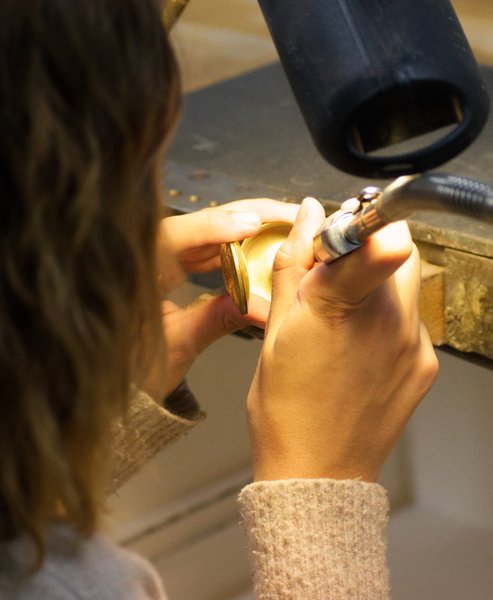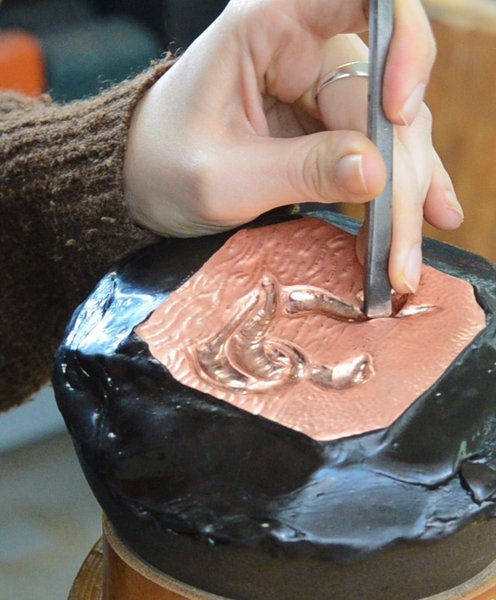Hanne Schonkeren
Art historian and goldsmith
PhD candidate at the Vrije Universiteit Brussel
About me
In 2018, I obtained a bachelor’s degree in goldsmithing and jewelry design at the Royal Academy of Fine Arts (Antwerp). Afterward, I studied art history and archaeology at the Vrije Universiteit Brussel (2018 – 2020) and dedicated my master’s thesis to the remaking of an early medieval fibula with filigree decoration. Currently, I am conducting a four-year Ph.D. project, funded by the Research Foundation - Flanders (FWO), investigating sixteenth-century Antwerp gold and silversmithing, at the Vrije Universiteit Brussel. This project is supervised by dr. Pieter Martens (VUB), dr. Tine Meganck (VUB) and dr. Sven Dupré (UU). I am a member of the research group Histories of Art, Architecture and Visual Culture (VISU).
Research
My four-year Ph.D. project, titled a performative and art historical study of gold and silversmithing in sixteenth-century Antwerp, is funded by the Research Foundation of Flanders (FWO).
This project investigates the products of sixteenth-century Antwerp gold and silversmithing through the innovative method of Reconstruction, Replication,
and Re-enactment (RRR). Focusing on ornamental cups, I aim to recreate the making processes of certain key elements of these artifacts. This performative research method will unveil the levels of craftsmanship and skill displayed in the cups.
Through close-up visual inspection, the reconstruction of strategically chosen components, techniques, and artistic processes, and documenting the social role of luxury objects, I intend to rewrite the traditional narrative about these so-called “minor arts”, reaching beyond the specific context of early modern Antwerp. More broadly, my research aims to reevaluate gold- and silversmithing art as a significant part of Renaissance culture.
Past projects
Master thesis: The making and meaning of early medieval silver equal-armed fibulae with filigree decoration: A case study of the curious fibula from Snellegem by means of experimental archaeology
The starting point of this research is a selection of equal-armed silver fibulae containing filigree and granulation decoration found across the southern North Sea area. Along with these objects, there are finds of silver fragments with filigree and granulation decoration and imitations in silver and lead, around this specific area. These imitations emphasize the importance of the silver fibulae. All the objects are dated around the 9th and 10th centuries. This research focuses on the fibula of Snellegem as a specific case study. By means of experimental archaeology, the chaîne opératoire of the early medieval goldsmith is reconstructed, to prove the importance of these objects in their socio-anthropological and cultural context. The reconstruction illustrates the principal differences between the fibulae, the importance of the fibulae as objects of status and last, the fibula of Snellegem could be considered as the original artefact that influenced the other finds.
Research paper about a late medieval artefact
During my preparation program, I became familiar with the method of experimental archaeology, where theories and hypotheses are tested through experiments. During this first year, I thus solved the mystery of a late medieval metal incomplete artifact found in a trash pit during an excavation in Aalst. Through experimental archaeology, I tried to find out how the artifact was technically constructed and to draw an overall picture of the original appearance and consumption of the artifact. The results of this research led to an article in Ex Situ, a magazine for Flemish archaeology, and the final result was exhibited by SOLVA in the exhibition Landscape Insight: Ten Years of Archaeological Research in South East Flanders.
Artistic work
My bachelor collection was inspired by my uncle, who was a photographer and turned blind. I discovered photographs that he made when he could still see. The main focus of these pictures was his wife, my godmother. I was inspired by the way he portrayed her as his muse - the pictures were a symbol of their youth and the happy life of newlyweds.
My uncle’s photographs are very valuable to me since they are the last evidence of his sight. That’s why I wanted my bachelor collection to have the same precious feeling. Apart from that, I was very close with my godmother, so this project for me was also a tribute to them and the relationship we had.
My aim was for these photographs to become wearable portraits. I want to convey a certain sensibility that shows ideas about family history, tragedy, youth, and the mother figure. These pieces pursue to show a different interpretation of portrait jewelry. The use of pearls in my collection contains an important personal link to the subject since it was a trademark of my godmother. Throughout this process of finding materials, I always kept blindness in mind. I wanted to make sure that there was always a strong texture so that the objects could be felt. I combined line drawings, castings, and pearls, resulting in static pearl necklaces.
The story of my godmother and uncle is a very personal one with great sentimental and symbolic value. However, I believe that there are certain symbols in the pieces that anyone can relate to - without having knowledge of my personal story - such as the mother figure, family heirlooms, and memories.
Interested in a collaboration, got a question, or just want to chat? Please feel free to contact me!








